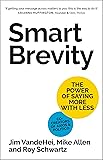
Smart Brevity

Now read all three parts together: your headline, your first-sentence lede and your Axiom. If this is all a person hears and learns, does it convey what matters most to you in the most blunt and understandable way possible? If the answer is yes, you have done more in 200 words than most people do with 20,000.
Jim VandeHei • Smart Brevity
After “Why it matters,” explain in one sentence—or at most two—why the information in your first sentence is important.
Jim VandeHei • Smart Brevity
“Why it matters” is the most common and effective Axiom. People are busy, their minds cloudy. They yearn for context even if they don’t know it or express it. Bold the words “Why it matters.”
Jim VandeHei • Smart Brevity
He is a gruff, grumpy, no BS journalistic throwback—and distills perfectly what every initial sentence should do: “Just tell me something I don’t f@$&ing know.”
Jim VandeHei • Smart Brevity
The first sentence is your one—and likely only—chance to tell someone what they need to know and convince them not to move on.
Jim VandeHei • Smart Brevity
If there is one thing you take away from this book, it is this: Learn to identify and trumpet ONE thing you want people to know. And do it in ONE strong sentence. Or no one will ever remember it. This is your most important point—or what journalists call “the lede.”
Jim VandeHei • Smart Brevity
In 10 words or less, write the reason you’re bothering to write something in the first place. • Write it in the most provocative yet accurate way possible.
Jim VandeHei • Smart Brevity
Start by stopping. • Stop using too many words in a headline or subject line. Limit yourself to 6 words, tops. • Stop being funny. Or ironic. Or cryptic. It’s confusing, not clever. • Stop using fancy SAT words or business-speak.
Jim VandeHei • Smart Brevity
The most important words you type are subject lines, headlines and the first line of tweets, notes or papers. You need to grab me, entice me, seduce me.